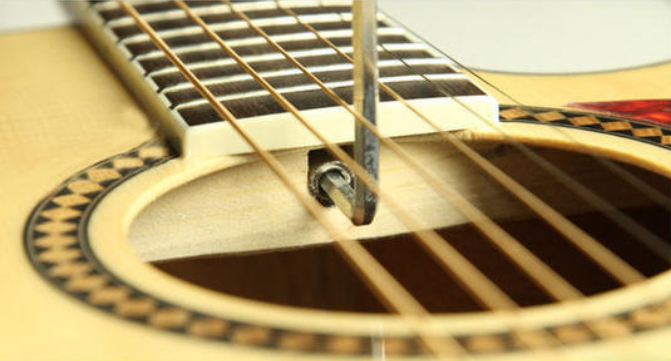The string pitch of a guitar refers to the distance between the string and the fingerboard (pinhead) below. When the distance is closer, the player can press the sound with less effort. On the contrary, it is more difficult. However, too small a pitch is likely to cause noise in playing. Therefore, there are indeed many technical problems and rules of thumb to pay attention to when adjusting! However, the adjustment of chord pitch has always been a technology that many guitar users cannot access, so it may finally be left to the shop owner or professional technician to handle. The purpose of this article is not to make everyone become a master of chord pitch adjustment, but to achieve “simple adjustment, you can do it yourself; for other adjustments, you can clearly know what the shop owner or technician has done? Is it reasonable?”, Don’t buy a shiny piano, but it’s hard to play it until you want to give it up. It’s a pity! Now let’s tell you four key directions. As long as you know these key steps and their relationship, you can know the principle of guitar adjustment!

1.Adjust Truss Rod bending
An adjusting rod will be embedded in the neck of an ordinary high-quality wooden guitar during the manufacturing process, so that it can be adjusted after the completion of the guitar to drive the bending of the neck wood. The significance of adjusting the bending is to make the fingerboard, strings closer to or away from each other. This will require some tools to assist you in adjusting the neck, such as hexagonal cricketers, sleeve cricketers, etc, Most of the adjustment holes are made inside the piano box, or some are made at the head of the piano, covered with a protective cover.
When adjusting the chord pitch of the guitar, first adjust the neck to a suitable feel without making the squeak of strings, and then adjust the height of the next upper chord pillow and lower chord pillow, which is relatively error free! My personal preference is that when you press the first-grade and the 12th grade of guitar at the same time, the string is close to the thickness of a business card, and you can get a great feel! But if you like the style of popping a little, you can raise it a little to avoid too much noise in the middle handle. You can freely try this part. The adjustment of the adjusting lever is easy and reversible, just rotate it repeatedly!
In addition, it should be made clear that the biggest difference in feel caused by adjusting the adjusting lever is between 3-12 grades of the guitar. Therefore, if you have a piano that is only first-grade difficult to play, or only the part that is more than 12 grades difficult to play, it will not help if you do not try to rotate the adjusting lever.
2.Adjust the height of the lower chord sleeper
The adjustment of the lower string pillow requires some experience values, which will directly affect how far the middle of the guitar is from the fingerboard. Generally speaking, the customary distance is the twelfth grid position of the guitar, and the distance between the string and the pintle is 2.6 – 2.8mm (from the lower end of the 12 pintle string to the upper end of the pintle). This also requires a special caliper to measure accurately.
If you want to adjust the height of the lower chord pillow, it is recommended to purchase the piano pillow with the height you need online.
3.Replace the upper piano pillow
If the groove of the upper chord pillow is obviously uneven, choose to replace the upper chord pillow directly. First, loosen the strings, then use a tool to gently hammer the upper chord pillow to make it fall off. Replace the upper chord pillow. After installing the new upper chord pillow, use a small amount of white latex, or do not use glue to tighten the strings
4.Check whether the thread is tilted
Observe whether there is any obvious bulge on one silk thread and other silk threads below it with an elevation angle of 45 degrees. If there is any obvious bulge, gently tap the silk thread with a tool until it fits the fingerboard. Check all silk threads again.
The basic principles have been explained above! But at the end, it must be emphasized that there is no certain standard for how high or low the guitar string pitch should be adjusted! It depends on the musicians’ usage habits and music style!
Therefore, there is no absolute data for the adjustment of the chord pitch of the guitar. As long as you can control the guitar well and the guitar will not cause any problems, you can adjust your guitar to a chord pitch that others think is too low or even too high. If you want to find a reliable custom CNC guitar neck manufacturer, visit CNCJY.COM.